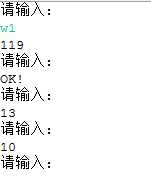JAVA中的System.in
阿新 • • 發佈:2019-03-18
oid 說明 嘗試 line mage [] main buffered int
System.in讀取標準輸入設備數據(從標準輸入獲取數據,一般是鍵盤),其數據類型為InputStream。方法:
int read() // 返回輸入數值的ASCII碼,,該值為0到 255範圍內的int字節值。若返回值為-1,說明沒有讀取到任何字節讀取工作結束。
int read(byte[] b) // 讀入多個字節到緩沖區b中,返回值是讀入的字節數
1 package InPackage; 2 3 /** 4 * System.in.read()返回值為輸入數值的ASCII碼,該值為0到 255範圍內的int字節值 5 * 如果因為已經到達流末尾而沒有可用的字節,則返回值 -1。6 */ 7 public class Intest1 { 8 public static void main(String args[]) throws java.io.IOException 9 { 10 int a=0; 11 System.out.println("請輸入a:"); 12 a=System.in.read(); 13 System.out.println("a="+a); 14 System.out.println("(char)a="+(char)a); 15} 16 /** 17 * 假設我們輸入a為1 18 * 輸出結果為: 19 * 請輸入a: 20 * 1 21 * a=49 22 * (char)a=1 23 */ 24
有一個有意思的問題是:當我們輸入一個字符,System.in.read()會讀取幾個字符呢?
1 package InPackage; 2 3 import java.util.Arrays; 4 5 /** 6 * 當我們輸入一個字符,System.in.read()會讀取幾個字符7 * 我們從運行結果可以看出是三個 8 * 假設我們輸入一個字符,那麽它會接著讀取該字符後面的/r和/n 9 */ 10 public class Intest2 { 11 public static void main(String[] args) throws Exception { 12 int[] x = new int[6]; 13 Arrays.fill(x, 5); //Arrays.fill(int[] a,int b)方法用於給數組中的每個元素賦值 14 for (int i = 0; i < x.length; i++) { 15 System.in.read(); 16 System.out.println(x[i]); 17 } 18 } 19 /** 20 * 假設我們輸入值分別為1,2 21 * 輸出結果: 22 * 1 23 * 5 24 * 5 25 * 5 26 * 2 27 * 5 28 * 5 29 * 5 30 */ 31 }
System.in.read()每次只是讀取一個字符,但它多讀取的是哪幾個字符呢?
import java.io.IOException; /** * System.in.read()每次只是讀取一個字符 * 按下回車鍵代表了兩個字符\r\n,\r的ASCII碼值是10,\n是13。另外,1對應的ASCII是49 */ public class Intest3 { public static void main(String args[]) throws IOException { for (int j = 0; j < 5; j++) { System.out.println("請輸入:"); char c = 0; c = (char) System.in.read(); if (c == ‘1‘) { System.out.println("OK!"); } else { System.out.println((int) c); } } } }
對於上面的程序,我們首先輸入的是w1,結果如下圖所示:

可以看出程序還沒有執行完,阻塞於最後一個“請輸入:”,此時我們再次輸入1,程序執行完成,結果如下圖所示:

如何讓System..in.read()讀入一行數據呢?
1 package InPackage; 2 3 import java.io.IOException; 4 5 public class Intest4 { 6 public static void main(String args[]) { 7 int b; 8 try { 9 System.out.println("請輸入:"); 10 while ((b = System.in.read()) != -1) { 11 System.out.print((char) b); 12 } 13 } catch (IOException e) { 14 System.out.println(e.toString()); 15 } 16 } 17 /** 18 * 輸出結果: 19 * 請輸入: 20 * test 21 * test 22 */ 23 }
1 package InPackage; 2 3 import java.io.BufferedReader; 4 import java.io.DataInputStream; 5 import java.io.InputStreamReader; 6 7 /** 8 * 通常情況下,你會用readLine( )一行一行地讀取輸入, 9 * 因此要把System.in包裝成BufferedReader。但在這之前還得先用InputSteamReader把System.in轉換成Reader。 10 * BufferedReader in = new BufferedReader(new InputStreamReader(System.in)); 11 * in.readLine()返回值為String類型 12 * 13 */ 14 public class Intest5 { 15 public static void main(String args[]) throws java.io.IOException { 16 System.out.println("請輸入整數:"); 17 BufferedReader reader = new BufferedReader(new InputStreamReader(System.in)); 18 //或者這麽寫也可以:DataInputStream reader = new DataInputStream(System.in); 19 int a = Integer.parseInt(reader.readLine()); // 這樣得到的是String類型的,需要轉換為需要的類型 20 System.out.println("a=" + a); 21 int sum = 0; 22 for (int i = 0; i <= a; i++) 23 sum += i; 24 System.out.println(sum); 25 } 26 /** 27 * 假設我們輸入a為100 28 * 輸出結果為: 29 * 100 30 * a=100 31 * 5050 32 */ 33 }
public int read(byte[] b) throws IOException又是怎麽使用的呢?
1 package InPackage; 2 3 /** 4 * public int read(byte[] b) throws IOException 5 * 從輸入流中讀取一定數量的字節,並將其存儲在緩沖區數組 b中。 6 * 返回值為:以整數形式返回實際讀取的字節數。 7 * 如果 b的長度為0,則不讀取任何字節並返回 0; 否則,嘗試讀取至少一個字節。 8 * 如果因為流位於文件末尾而沒有可用的字節,則返回值 -1;否則,至少讀取一個字節並將其存儲在b中。 9 * 10 */ 11 public class Intest6 { 12 public static void main(String args[]) throws Exception { 13 byte[] barray = new byte[5]; 14 System.out.println("請輸入:"); 15 System.in.read(barray); 16 for (int i = 0; i < barray.length; i++) { 17 System.out.println((char) barray[i]); 18 } 19 } 20 }
轉載:https://www.cnblogs.com/ningvsban/p/3593817.html
JAVA中的System.in
